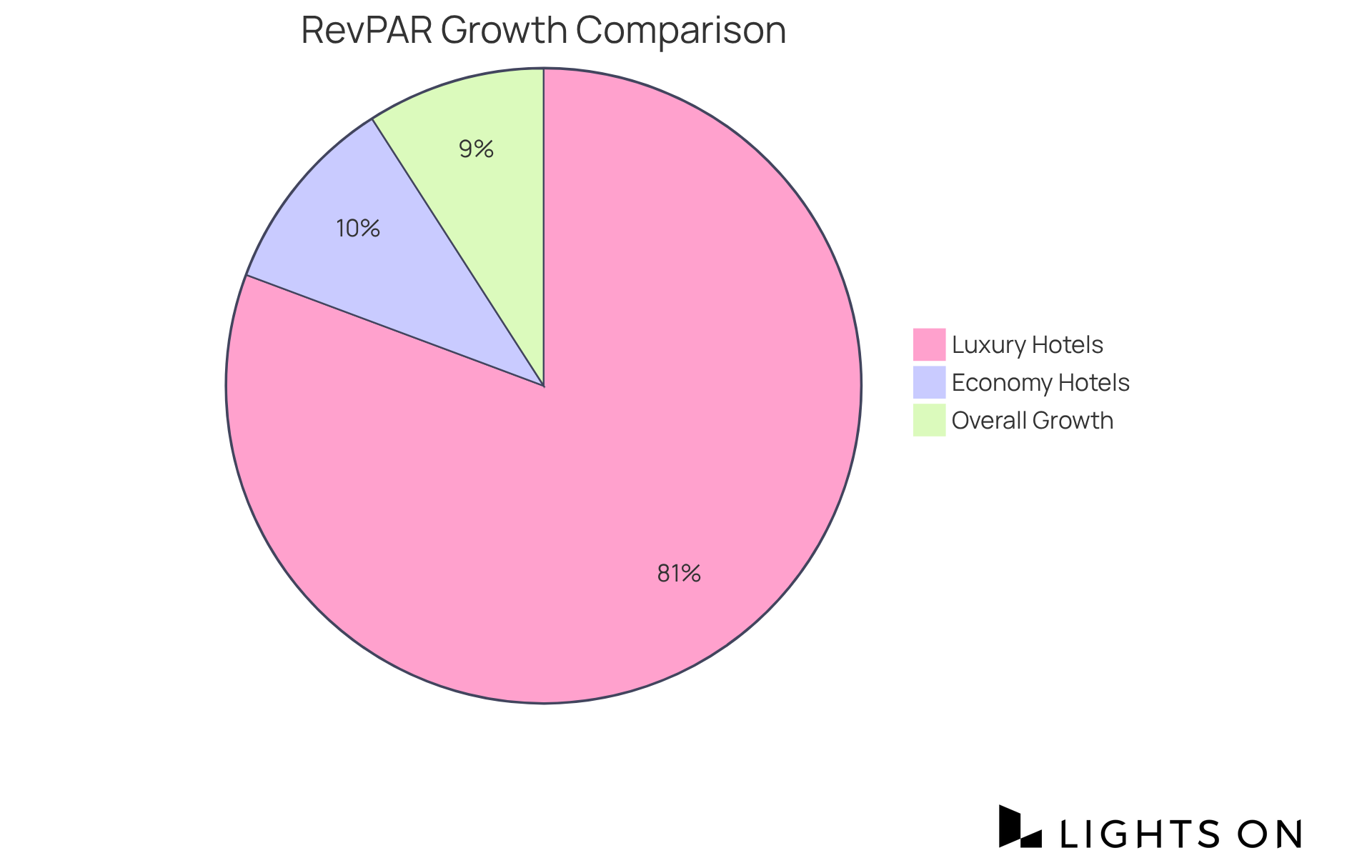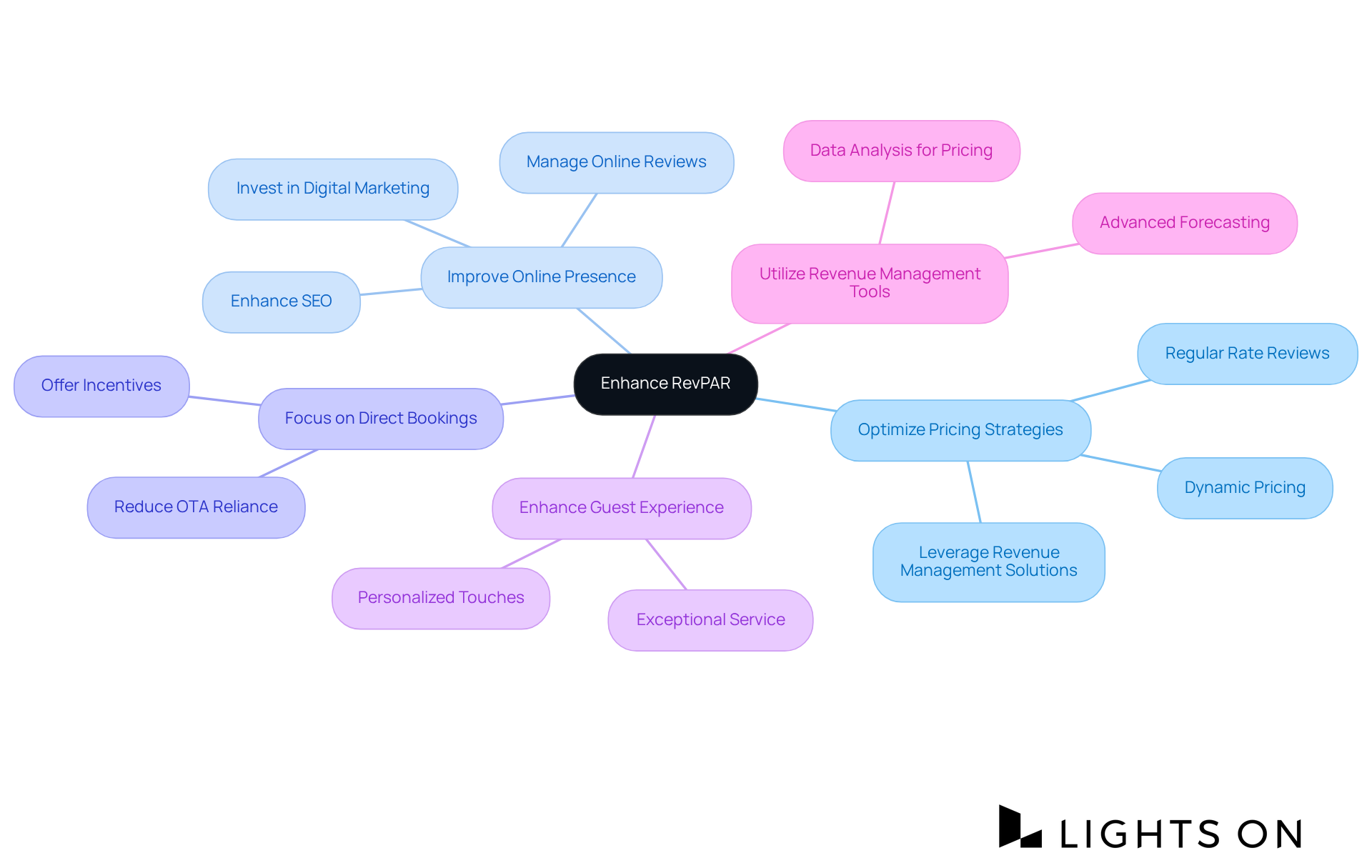The article delves into mastering Revenue per Available Room (RevPAR) within the hotel industry, outlining pivotal strategies for achieving success. It asserts that effective pricing strategies, a robust online presence, and enhanced guest experiences are indispensable for optimizing RevPAR. These factors directly influence financial performance and profitability in an increasingly competitive market. Furthermore, understanding these elements not only addresses current challenges but also positions hotel owners for future growth.
In the competitive realm of the hotel industry, understanding Revenue per Available Room (RevPAR) is crucial for success. This key metric not only reflects a hotel's ability to generate income but also serves as a guiding light for strategic decision-making.
As the landscape shifts toward 2025, with luxury hotels thriving amid economic challenges, hoteliers face a pressing question: how can they effectively leverage RevPAR to enhance profitability and navigate an ever-evolving market?
This article delves into the intricacies of RevPAR, offering essential strategies and insights for mastering this vital component of revenue management.
The revpar hotel industry, or Revenue per Available Room, stands as a pivotal metric within the hospitality sector, measuring an establishment's ability to generate income from its available rooms. This figure is calculated by dividing total room income by the number of available rooms, regardless of booking status. For accommodation providers, this metric is invaluable as it provides insights into occupancy and pricing strategies, thereby facilitating improved financial forecasting and performance evaluation.
As we look toward 2025, the landscape for the revpar hotel industry is shaped by various trends. For instance, luxury hotels have experienced a year-to-date growth of 7.1% in revenue per available room, while economy hotels have seen a mere 0.9% increase, indicating a divergence in market performance. Moreover, the overall growth in the revpar hotel industry is expected to decelerate to 0.8%, reflecting challenges posed by macroeconomic factors such as inflation, which is projected to rise to 2.7%.
Understanding revenue per available room within the revpar hotel industry empowers hoteliers to , set competitive pricing, and enhance marketing strategies, ultimately driving profitability. A robust revenue per available room in the revpar hotel industry not only covers operating expenses but also signifies effective pricing and utilization strategies, making it a critical component of revenue management. Case studies reveal that accommodations can influence their revenue per available room within the revpar hotel industry by strategically adjusting average daily rates and guest levels. For example, an establishment that lowered its prices to boost guest numbers saw its revenue per available room drop from $280 to $175, underscoring the importance of a balanced approach.
To effectively leverage revenue per available room data in the revpar hotel industry, hotel owners should consider implementing targeted marketing strategies such as:
These tactics can attract more visitors and optimize room utilization, ultimately leading to enhanced revenue per available room. In a competitive market, mastering revenue per available room in the revpar hotel industry can be the defining factor for success or failure in the hospitality sector, encapsulating the efficiency of revenue generation and room utilization.

To , utilize the formula: RevPAR = Total Room Revenue / Total Available Rooms. Alternatively, RevPAR can be determined by multiplying the Average Daily Rate (ADR) by the occupancy rate: RevPAR = ADR x Occupancy Rate. For example, if a hotel generates a total room revenue of $100,000 with 1,000 available rooms, the RevPAR would be $100.
Several factors significantly influence the RevPAR in the hotel industry, including:
For instance, accommodations employing dynamic pricing strategies can adjust rates in real-time according to demand, thereby optimizing revenue potential. Furthermore, understanding market trends and guest preferences enables hotel managers to refine their strategies, ensuring competitiveness in a rapidly evolving landscape.
It's crucial to note that the revenue per available room percentage change can be computed as (revenue per available room This Year/revenue per available room Past Year) - 1, providing a valuable measure for monitoring performance over time. MarginPAR, or Profit Per Available Room, also plays a vital role in assessing how effectively revenue is converted into profit, offering a broader perspective on financial performance.
Industry leaders emphasize the importance of these metrics; "This metric bridges the gap between occupancy rates and average room rates, providing hoteliers with a thorough perspective on their property's profitability." A comprehensive strategy for revenue management can yield substantial advancements in the RevPAR hotel industry, ultimately enhancing a hotel's financial performance. Additionally, it is essential to exclude unavailable rooms from the revenue per available room calculation due to renovations or temporary closures to ensure accuracy. Finally, the revenue per available room index aids hoteliers in evaluating their performance against competitors, offering essential context for strategic modifications.

To enhance RevPAR, consider implementing the following strategies:

RevPAR hotel industry (Revenue per Available Room) is fundamentally linked to both Average Daily Price (ADR) and the proportion of occupied rooms—two essential metrics in the hospitality sector. ADR measures the average revenue generated per rented room, while the rate of filled rooms indicates the percentage of available rooms sold. The interplay between these metrics can significantly influence a lodging establishment's financial performance.
An increased ADR can improve revenue per available room, provided the rate of filled rooms remains consistent. For example, if an accommodation achieves an ADR of $150 with a 70% utilization percentage, the resulting revenue per available room would be $105. Conversely, a rise in the rate of occupied rooms can boost revenue per available room even if the average daily rate is lower. This dynamic is crucial for accommodation managers aiming to optimize revenue through strategic pricing and marketing initiatives.
To effectively utilize revenue per available room for boosting reservations, hotel proprietors should consider incorporating focused marketing approaches that align with booking patterns. For instance, marketing initiatives during high demand periods can enhance revenue, while special deals during low demand times can assist in increasing guest numbers. Current patterns in 2025 emphasize the significance of utilization rates in influencing results within the revpar hotel industry. For instance, Minneapolis experienced an impressive 16.7% increase in revenue per available room, driven by enhanced group activity and a resurgence in business travel, despite diminished baseline occupancy rates. In contrast, Las Vegas and New Orleans faced declines in the revpar hotel industry of 15.0% and 6.2%, respectively, due to softer event calendars and shifting consumer demand.
Understanding these relationships enables accommodation managers to make . As industry expert Ira Vouk noted, "If you don’t measure it, you can’t change it." By closely monitoring occupancy rates alongside ADR and implementing effective marketing strategies, hotels can better navigate market fluctuations and enhance their overall profitability.

Mastering Revenue per Available Room (RevPAR) is not just beneficial; it is essential for success in the hotel industry, serving as a key indicator of financial performance and operational efficiency. By understanding and leveraging this critical metric, hoteliers can make informed decisions that enhance profitability and adapt to the ever-evolving market landscape.
Throughout this article, we discussed various strategies for improving RevPAR. These include:
Each of these approaches plays a crucial role in maximizing revenue potential and ensuring competitive positioning in the hospitality sector. Furthermore, the relationship between RevPAR, Average Daily Rate (ADR), and occupancy rates was highlighted as a vital consideration for hotel managers aiming to refine their pricing and marketing strategies.
Ultimately, the significance of RevPAR extends beyond mere calculations; it reflects the overall health and viability of a hotel’s business model. By prioritizing effective revenue management practices and continuously monitoring key performance indicators, hoteliers can navigate market fluctuations and seize opportunities for growth. Embracing these insights and strategies will not only enhance RevPAR but also contribute to long-term success in the dynamic world of hospitality.
What does RevPAR stand for and why is it important in the hospitality industry?
RevPAR stands for Revenue per Available Room. It is a crucial metric that measures a hotel's ability to generate income from its available rooms, providing insights into occupancy and pricing strategies.
How is RevPAR calculated?
RevPAR is calculated by dividing total room income by the number of available rooms, regardless of their booking status.
What trends are currently influencing RevPAR in the hotel industry?
As of 2025, luxury hotels have experienced a 7.1% growth in RevPAR, while economy hotels have only seen a 0.9% increase. The overall growth in the RevPAR hotel industry is expected to slow to 0.8% due to macroeconomic factors like inflation, which is projected to rise to 2.7%.
How can understanding RevPAR benefit hoteliers?
Understanding RevPAR allows hoteliers to identify market trends, set competitive pricing, and enhance marketing strategies, ultimately driving profitability and improving financial forecasting.
What role does pricing strategy play in RevPAR?
A robust RevPAR indicates effective pricing and utilization strategies. Hotels can influence their RevPAR by strategically adjusting average daily rates and guest levels.
Can you provide an example of how pricing adjustments affect RevPAR?
For example, a hotel that lowered its prices to increase guest numbers saw its RevPAR drop from $280 to $175, highlighting the need for a balanced approach in pricing strategies.
What marketing strategies can hotels implement to improve RevPAR?
Hotels can implement targeted marketing strategies such as dynamic pricing, promotional packages, and loyalty programs to attract more visitors and optimize room utilization.
Why is mastering RevPAR critical for success in the hospitality sector?
Mastering RevPAR is essential in a competitive market as it encapsulates the efficiency of revenue generation and room utilization, which can determine the success or failure of a hospitality business.
Transform your group booking strategies with Lights On and watch your occupancy soar.